Overnight, Refrigerator Focaccia = The Best Focaccia Bread Recipe
This post may contain affiliate links. Please read my disclosure policy.
Cold, refrigerated dough is the secret to making delicious focaccia! Allowing the dough to rest 18 to 48 hours in the fridge will yield extra-pillowy and airy focaccia, though if you are pressed for time, you can make this start-to-finish in 3 hours. This 4-ingredient recipe requires only 5 minutes of hands-on time. Video guidance below!
⭐️⭐️⭐️⭐️⭐️ Review:
“Love this recipe! I’ve made this so many times that I’ve lost count. Super simple and delicious. My family loves it. Whenever someone asks me for a focaccia recipe, I always show them this one. This recipe is awesome. Thank you for sharing!” — Lucy
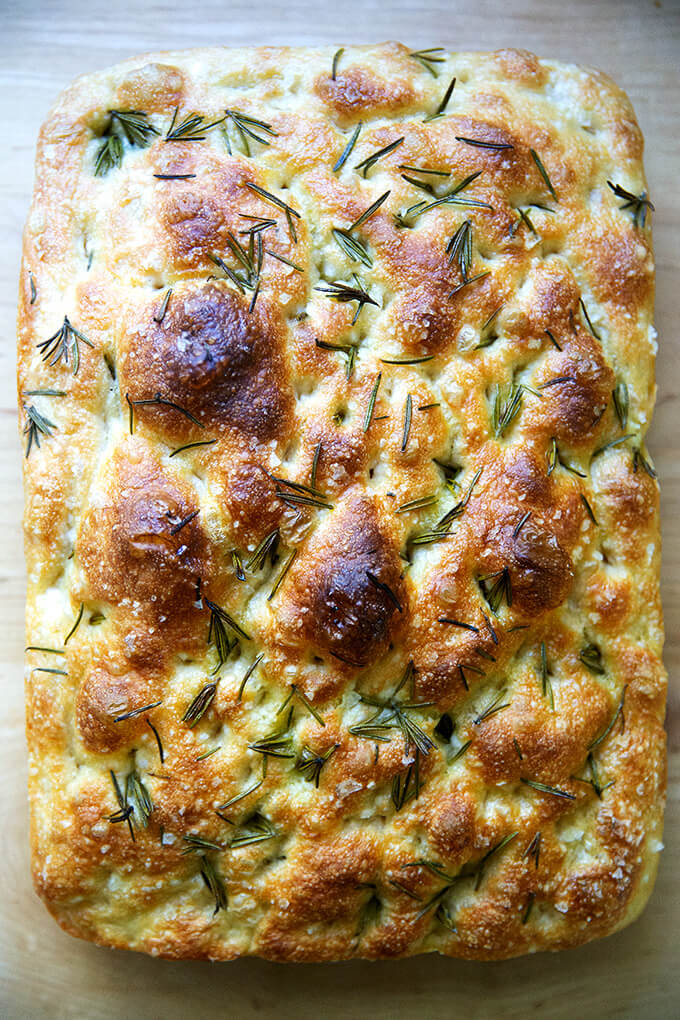
I’ve said it before and I’ll say it again: focaccia is the bread recipe for beginners. Why? Because:
- The no-knead, 4-ingredient dough takes 5 minutes to mix together.
- It requires no special equipment, no tricky shaping technique, and no scoring.
- If you have a 9×13-inch baking pan and your fingertips (for dimpling), you’re good to go.
- It emerges soft and pillowy, olive oil-crusted, golden all around, and it’s completely irresistible.
In sum, it’s hard to beat focaccia (pronounced foh-kah-chuh) in the effort-to-reward category. If you are intimidated by bread baking, this is the recipe I suggest making first, both for its simplicity and flavor. After all, this focaccia bread recipe is adapted from my mother’s simple peasant bread recipe, a recipe that has removed the fear of the bread baking process for many.
For the past few months, I’ve been making the focaccia bread recipe from my cookbook Bread Toast Crumbs, but changing the method: using more yeast, using less yeast, doing longer, slower rises at room temperature, doing longer, slower rises in the refrigerator. Find the results below.
This post is organized as follows:
- What Makes The Best Focaccia
- Four Tips for Success
- How This Focaccia Recipe Differs from Others
- Focaccia Bread Ingredients
- How to Make Focaccia, Step by Step
- Adding Rosemary, Herbs and Other Toppings to your Focaccia Dough
- How to Make a Focaccia Bread Art
- Tomato Focaccia
- How to Make a Focaccia Bread Sandwich
- Can I Skip the Overnight Rise?
PS: Once you master this simple focaccia, try your hand at this simple sourdough bread recipe, another recipe that requires minimal effort but yields spectacular results.
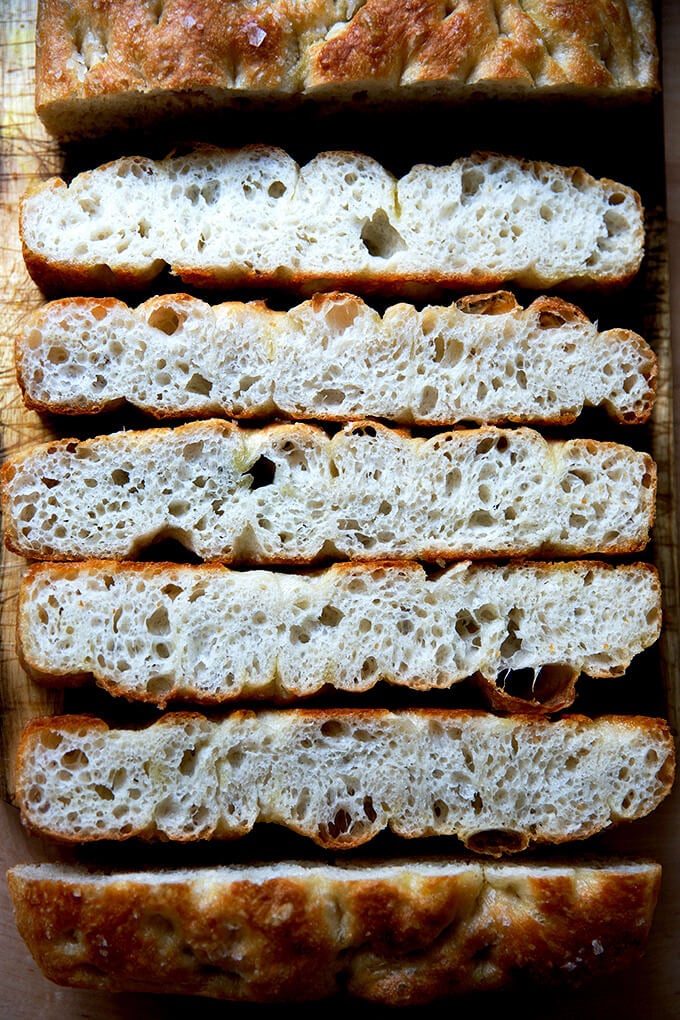
What Makes The Best Focaccia?
I’ll spare you all the details of the various experiments and skip straight to what I’ve found creates the best focaccia, one that emerges golden all around, looking like a brain, its surface woven with a winding labyrinth of deep crevices: high-hydration, refrigerated dough.
This is nothing novel—many bakers extol the virtues of the cold fermentation process—and it came as no surprise to me either: it was, after all, past-prime Jim Lahey refrigerated dough that showed me how easy focaccia could be: place cold, several-days-old pizza dough in a well-oiled pan, let it rise for several hours or until it doubles, drizzle with more oil, dimple with your fingers, sprinkle with sea salt, then bake until done.
Employing a refrigerator rise requires more time because the cold environment slows everything down initially, and during the second rise, the cold dough takes time to warm to room temperature. The overall effort, however, is very hands-off, and the result — a light, airy, pillowy dough — is well worth it.
As important as refrigerating the dough is using a high hydration dough, meaning a dough with a high proportion of water relative to the flour. The high proportion of water will create a dough with beautiful air pockets throughout. (Incidentally, this is the secret to making excellent pizza dough as well as light, airy sourdough sandwich bread.)
How This Focaccia Recipe Differs from Others
There are lots of focaccia bread recipes out there, so why make this one? This one differs from many of the recipes out there in two ways:
- The long, cold, refrigerator rise.
- The absence of sugar or honey or any sort of sweetener.
Why isn’t there any sweetener in this recipe? Simply stated, a sweetener is just not needed — the yeast, contrary to popular belief, does not need sugar to activate or thrive. Sugar will speed things up, but when you’re employing a long, slow rise, speed is not the name of the game.
Moreover, and this is getting a little scientific, but during the long, cold fermentation: enzymes in both the flour and the yeast will break down the starches in the flour into simple sugars, which will contribute both to flavor and to browning, again rendering sugar unnecessary. Cool, right?
Four Tips for Success
- Allowing the dough to rest 18 to 24 hours in the fridge yields the best results. (You can leave the dough in the fridge for as long as 72 hours.)
- A buttered or parchment-lined pan in addition to the olive oil will prevent sticking. When I use Pyrex or other glass pans, butter plus oil is essential to prevent sticking. When I use my 9×13-inch USA Pan, I can get away with using olive oil alone.
- Count on 2 to 4 hours for the second rise. This will depend on the temperature of your kitchen and the time of year.
- After the second rise, dimple the dough, then immediately stick the pans in the oven — this has been a critical difference for me in terms of keeping those desirable crevices. If you dimple and let the dough rise again even for 20 minutes before popping the pan in the oven, the crevices begin to dissolve.
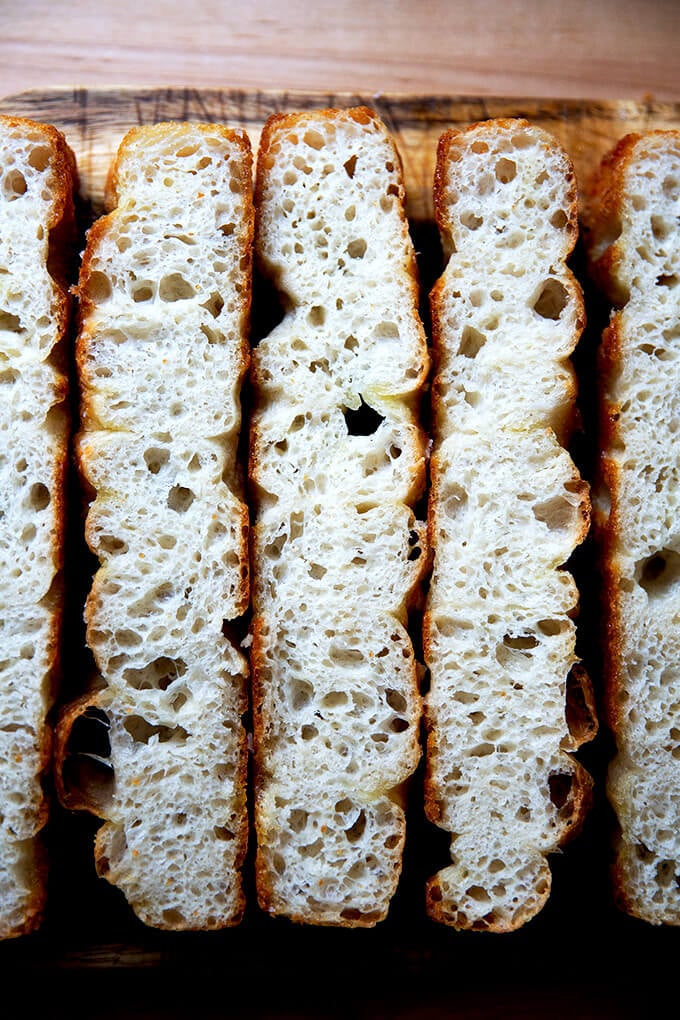
Ingredients
- Flour: bread flour or all-purpose flour will work equally well here. If you live in a humid environment or abroad, I suggest trying to get your hands on bread flour. King Arthur Flour is my preference.
- Yeast: SAF Instant Yeast is my preference, but active dry yeast works just as well. See recipe box for instructions on how to use active-dry yeast in place of instant.
- Salt: I say this all the time, but a big part of making a good loaf of bread comes down simply to using the right amount of salt given the amount of flour you are using by weight. It’s like anything: bread has to be well seasoned. At a minimum, use 10 grams (2 teaspoons) of salt for every 500 grams (4 cups) of flour. I highly recommend investing in some good, flaky sea salt for sprinkling on top of the focaccia dough — it tastes better than the more finely ground varieties of salt. I use Diamond Crystal kosher salt for the dough, but any salt you have on hand will work just fine for the dough.
- Water: There is a lot of water in this dough — it’s 88% hydration — and all of that water helps produce a light, airy, pillowy dough.
- Olive oil: Olive oil both in the bottom of the pan and on top of the dough is essential for encouraging nice browning, flavor, and that quintessential oiliness we all love about focaccia.
- Rosemary or other seasonings: Rosemary is a classic focaccia topping, and you can either sprinkle it over the dough before baking or you can chop it up and add it to the dough. Many people love sun-dried tomatoes and olives in their focaccia. See below for how to incorporate these other ingredients into your focaccia dough.
How to Make Focaccia Bread, Step by Step
Gather your ingredients: 4 cups (512 g) flour, 2 teaspoons (10 g) salt, 2 teaspoons (8 g) instant yeast (SAF is my preference), 2 cups (455 g) water:
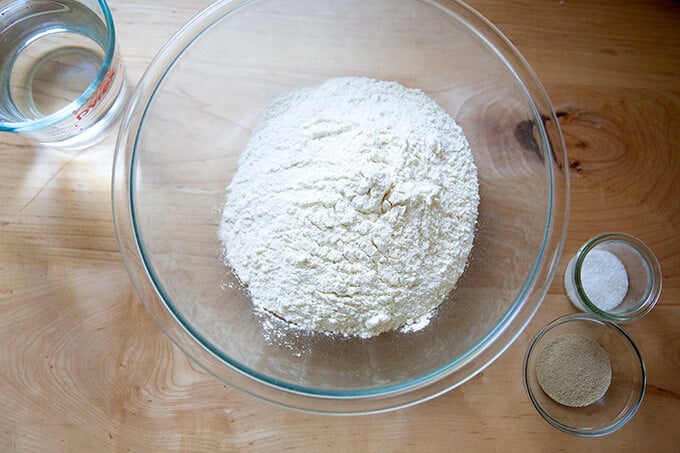
Whisk together the flour, salt, and yeast first:
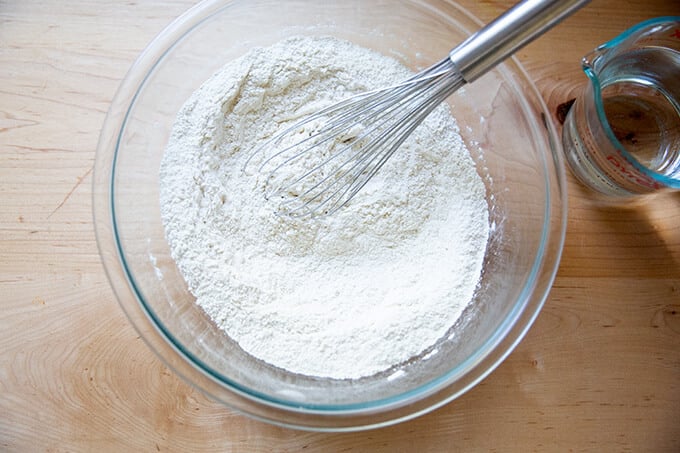
Add the water:
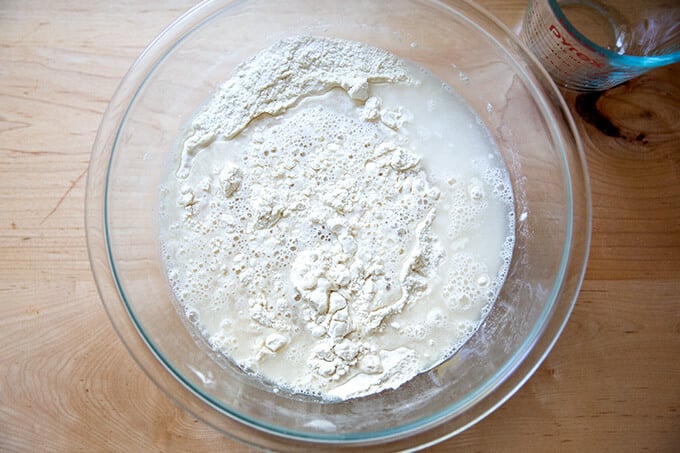
Use a spatula to stir the two together.
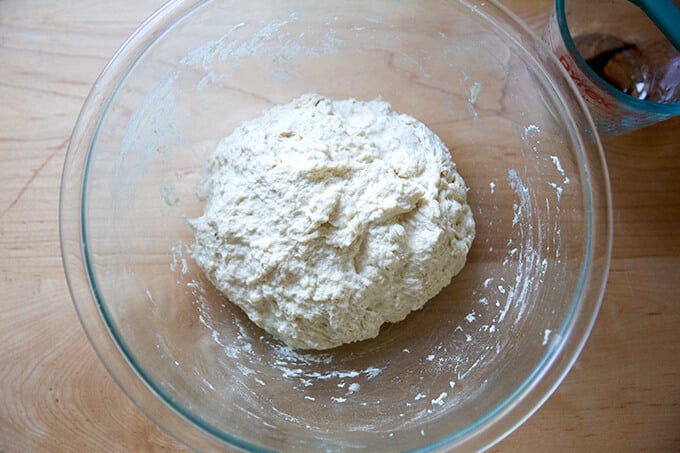
Slick the dough with olive oil:
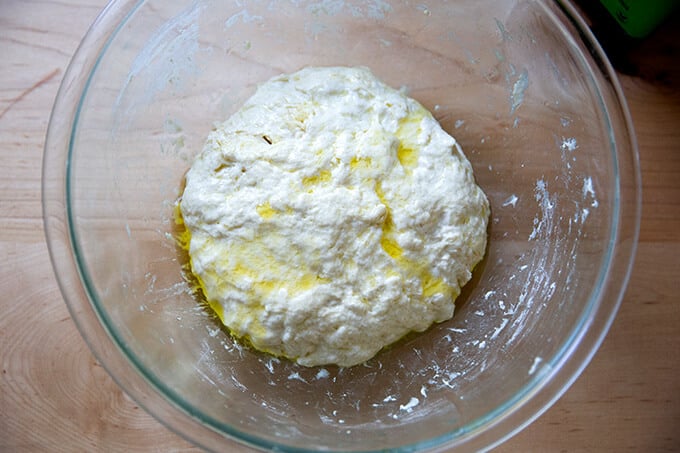
Slick the surface of the dough with olive oil; then cover the bowl. You all have one of these, right? Stick the bowl in the fridge immediately; leave it there to rise for 12 to 18 hours (or longer—I’ve left it there for as long as three days). NOTE: It is important the dough really be slicked with olive oil especially if you are using a cloth bowl cover or tea towel as opposed to plastic wrap or the lid pictured in the photo below this one. If you are using a tea towel, consider securing it with a rubber band to make a more airtight cover. If you do not slick the dough with enough oil, you risk the dough drying out and forming a crust over the top layer.
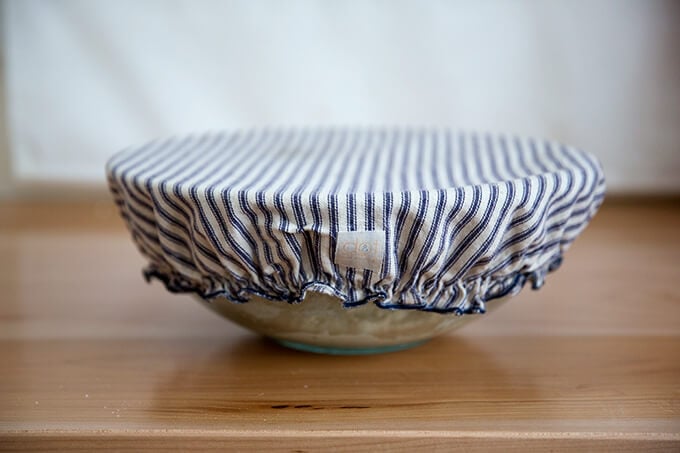
Another option: the lid that comes with the 4-Qt Pyrex bowl. This is handy for fridge storage because you can stack things on top of it.
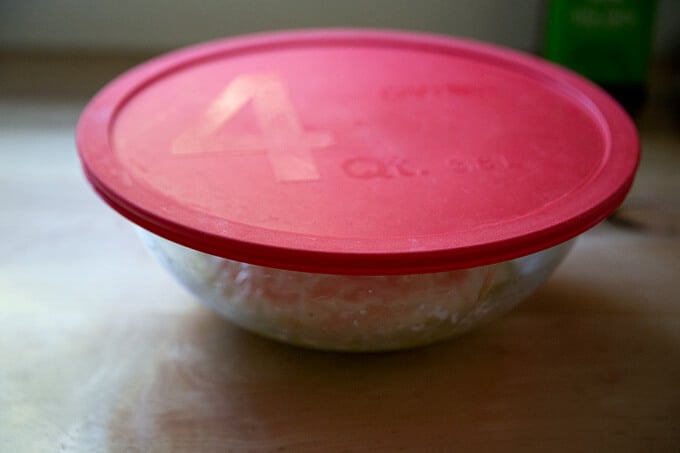
Remove from fridge, and remove the cover:
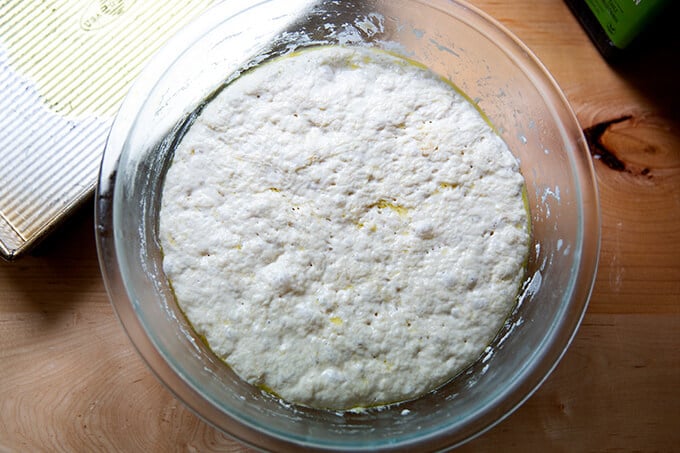
Deflate the dough and transfer to a prepared pan. I love this 9×13-inch USA pan. If you don’t have one you can use two 8- or 9-inch pie plates or something similar. If you are using glass baking dishes be sure to grease the dishes with butter before pouring a tablespoon of olive oil into each. (The butter will ensure the bread doesn’t stick.) Don’t touch the dough again for 2 to 4 hours depending on your environment.
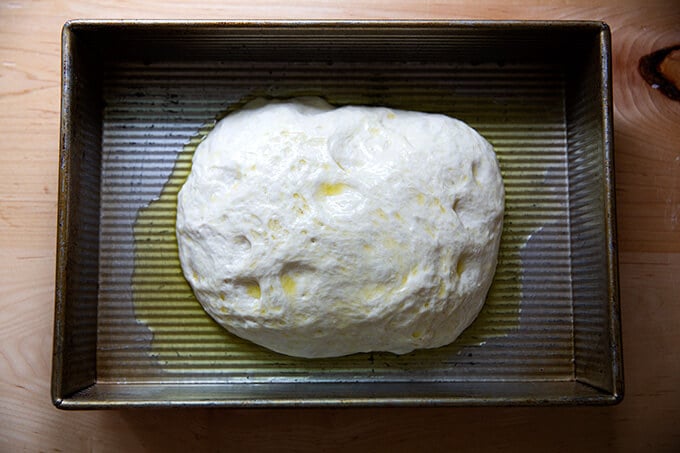
After two to four hours, or when the dough looks like this…:
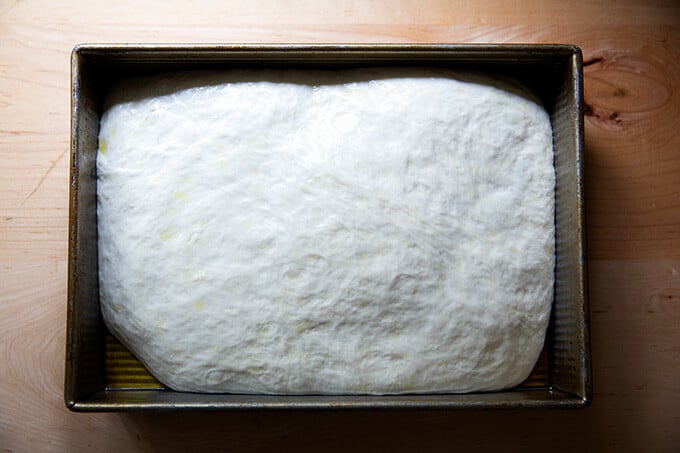
… it’s time to dimple it! You can use simply olive oil and salt — I recommend good, flaky sea salt for this. Note, the dough in the photo below spent three days in the fridge, and the dough was super bubbly!
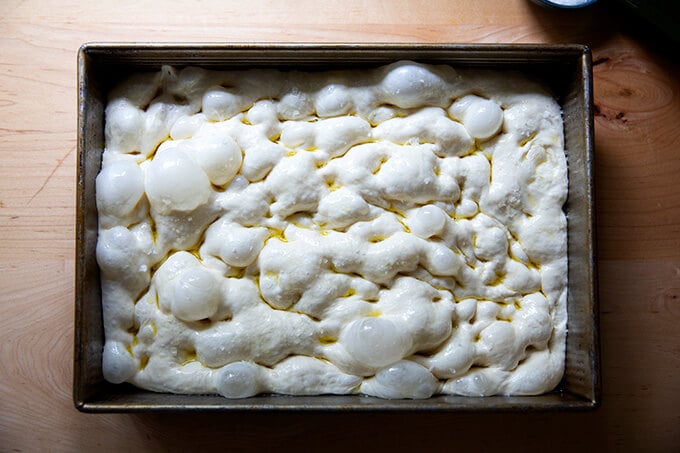
if you are using rosemary, sprinkle it over the dough. Then pour two tablespoons of olive oil over the dough, and using your fingers, press straight down to create deep dimples. Sprinkle with flaky sea salt — again, something like Maldon is great here.
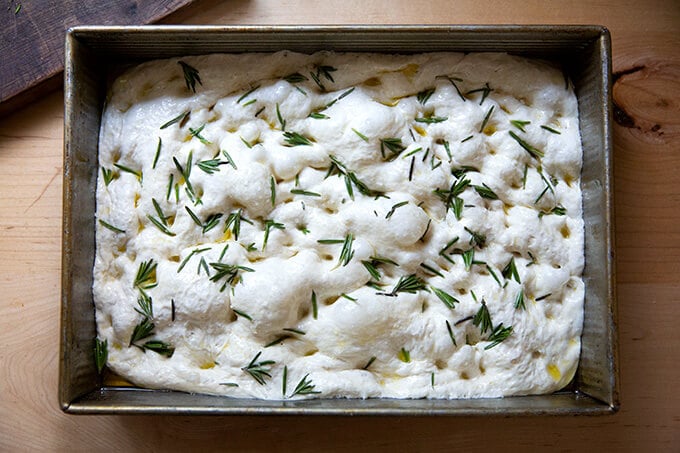
Transfer to oven immediately and bake at 425ºF for 25 minutes or until golden all around. Remove focaccia from pans and place on cooling racks.
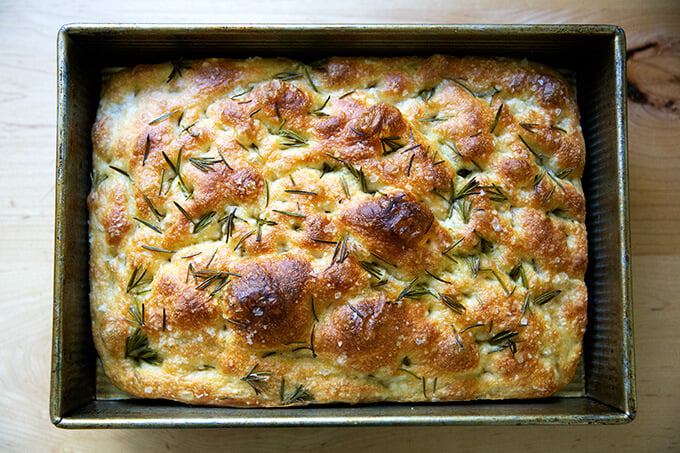

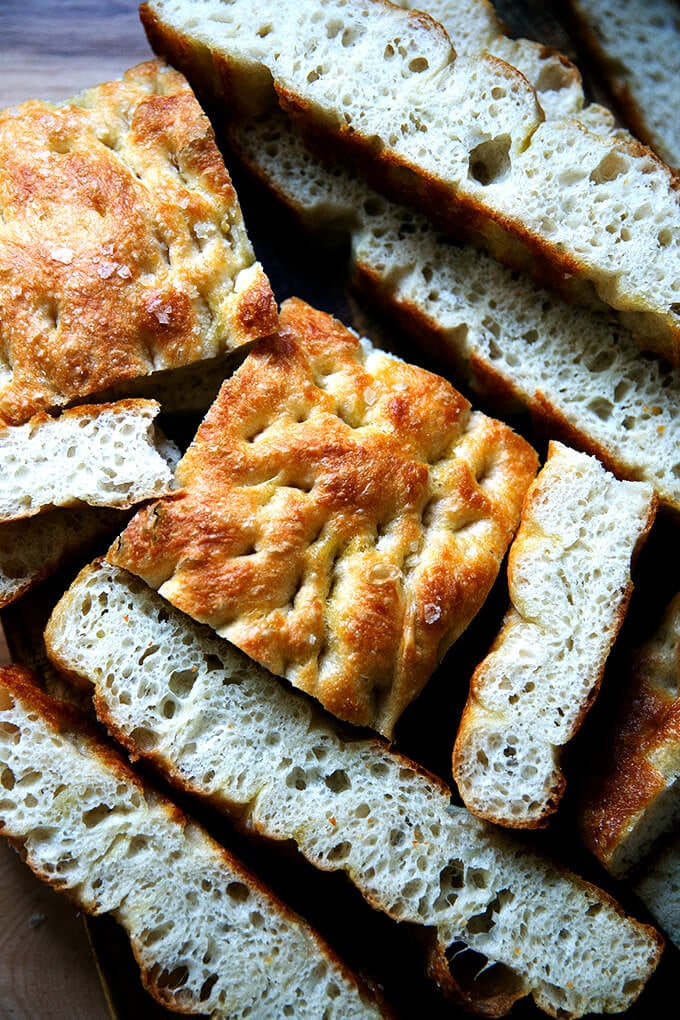
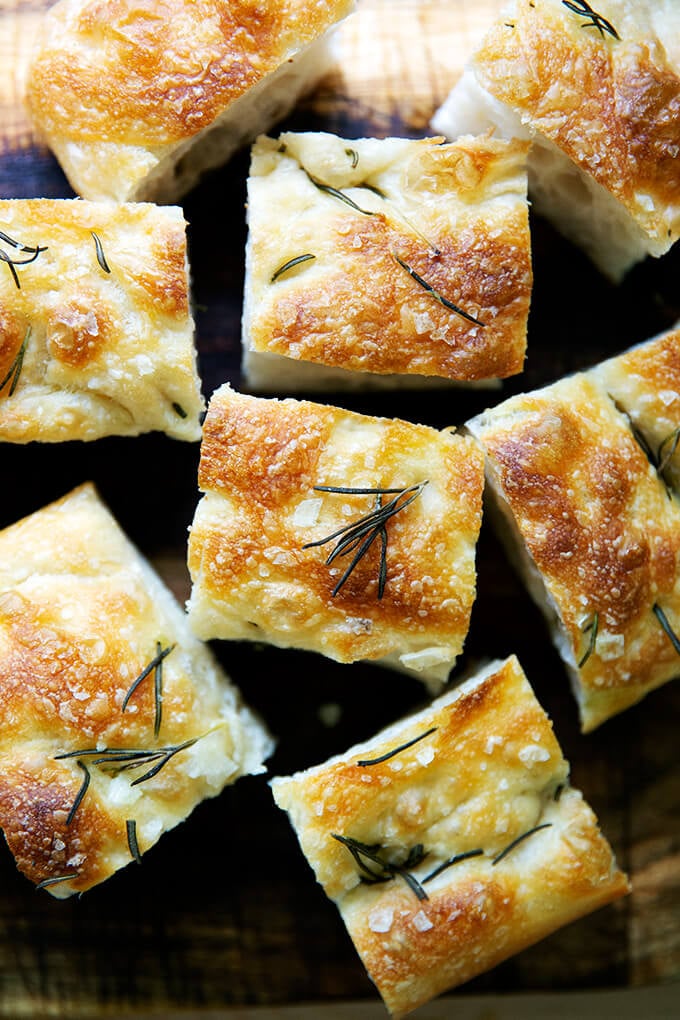
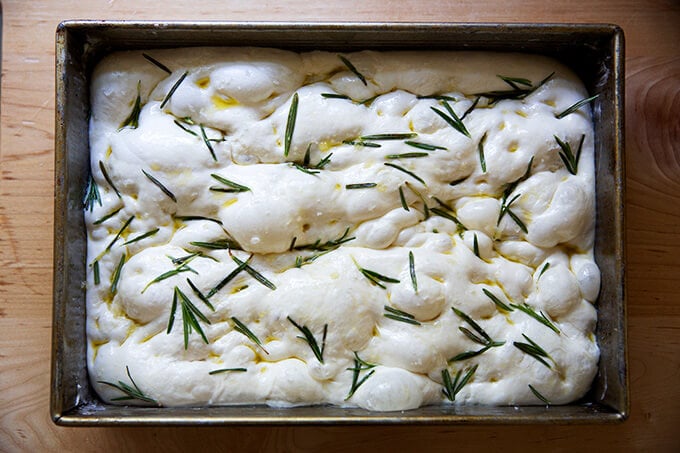
How to Incorporate Rosemary, Herbs, and Other Ingredients & Toppings into Your Focaccia Dough
One of the most frequently asked questions I get is: How can I add other toppings or ingredients to my focaccia bread? You can do this in two ways:
- Add them on top as you would rosemary or other herbs. The key is to make sure the ingredients are slicked lightly with olive oil to ensure they do not burn in the oven. I like to sprinkle the rosemary over top of the dough, then drizzle it with olive oil, then dimple the dough.
- You can add them directly to the dough. In step one, when you whisk together the flour, salt, and instant yeast, add your ingredients — chopped olives, sun-dried tomatoes, roasted garlic — to the flour and toss to coat; then add the water.
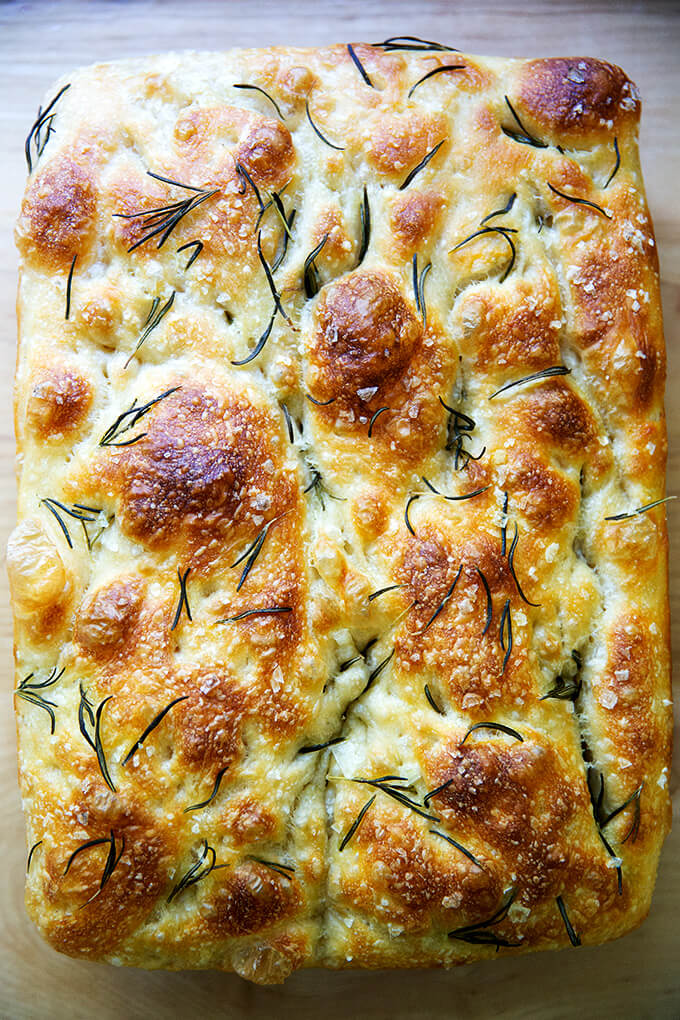
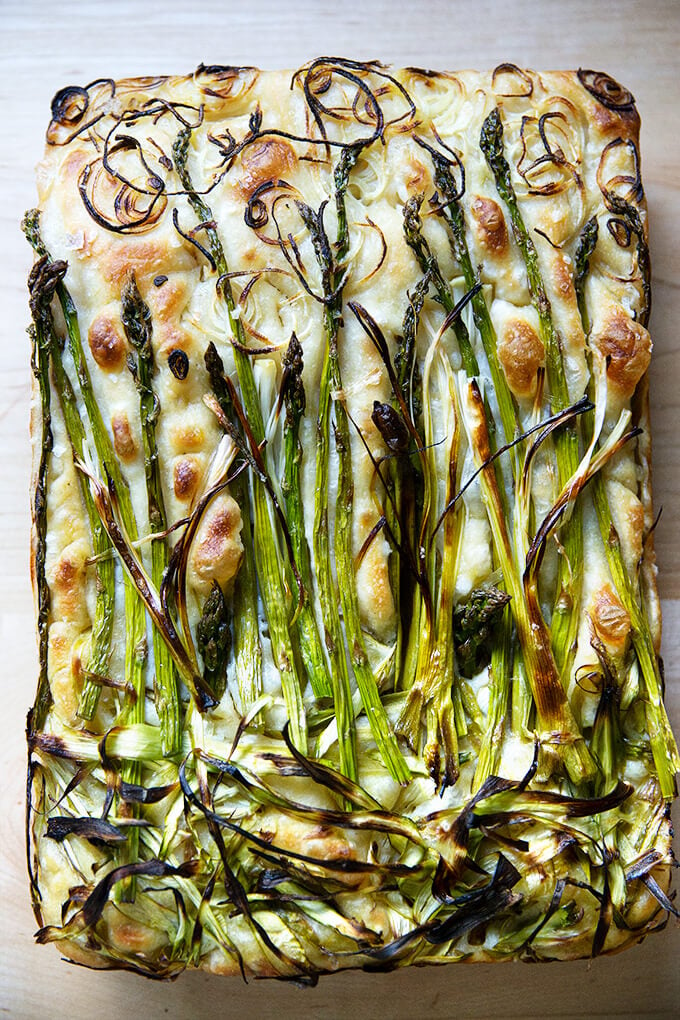
How to Make a Focaccia Bread Art
Pictured above is my “Ode to Spring” (🤣) Focaccia Bread Art (or Garden Scape). As noted above, the key with adding toppings is to slick them lightly with olive oil to ensure they don’t completely char. Keep in mind that some items will char, and a little charring is not a bad thing.
To make a focaccia bread art:
- Follow the recipe through the step in which you dimple the dough just before baking. Arrange your toppings — sliced peppers, asparagus, scallions, olives, tomatoes, onions, etc. — over top and dimple again, pressing the ingredients into the dough to embed them — you can be more aggressive than you think.
- Brush the entire surface with olive oil; then sprinkle with sea salt.
- Bake as directed.
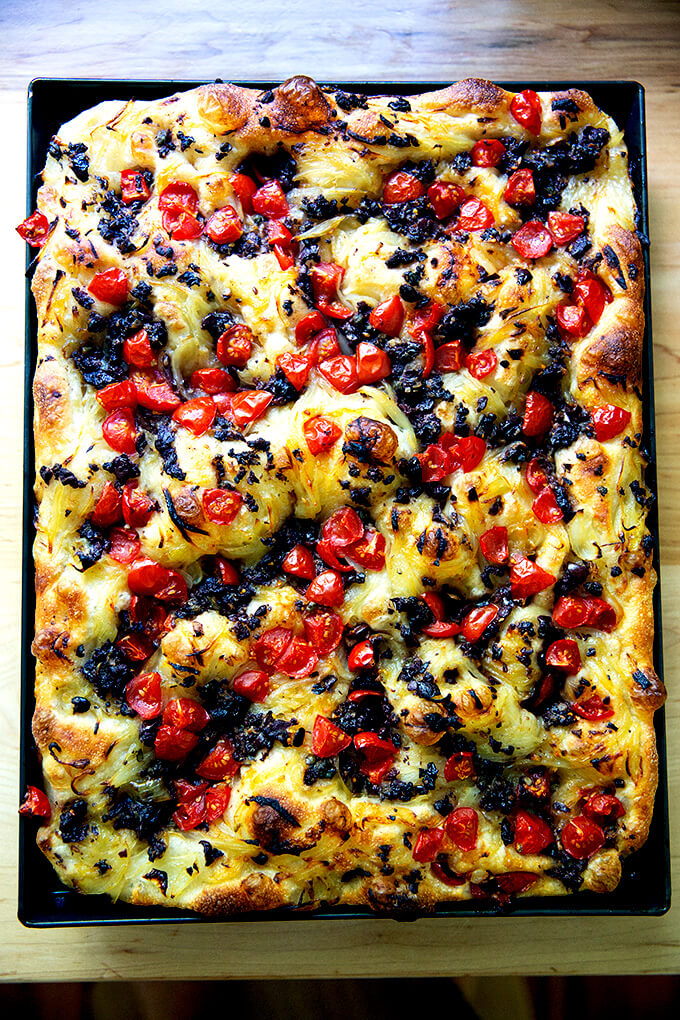
Tomato Focaccia
Pictured above is a cross between pissaladière and tomato focaccia. I love the addition of tomatoes to pissaladière because it adds a freshness and brightness, a hit of acidity to offset the sweet caramelized onions and salty anchovies, olives, and capers.
You can use any summer tomatoes you have on hand — diced cherry tomatoes, Roma, plum, sliced beefsteak tomatoes, heirloom tomatoes, etc. If you choose to dice up Roma or plum tomatoes, there is no need to seed them, but leave any juices lingering on the cutting board behind.
Top the unbaked focaccia with a thin layer of tomatoes; then bake as directed.
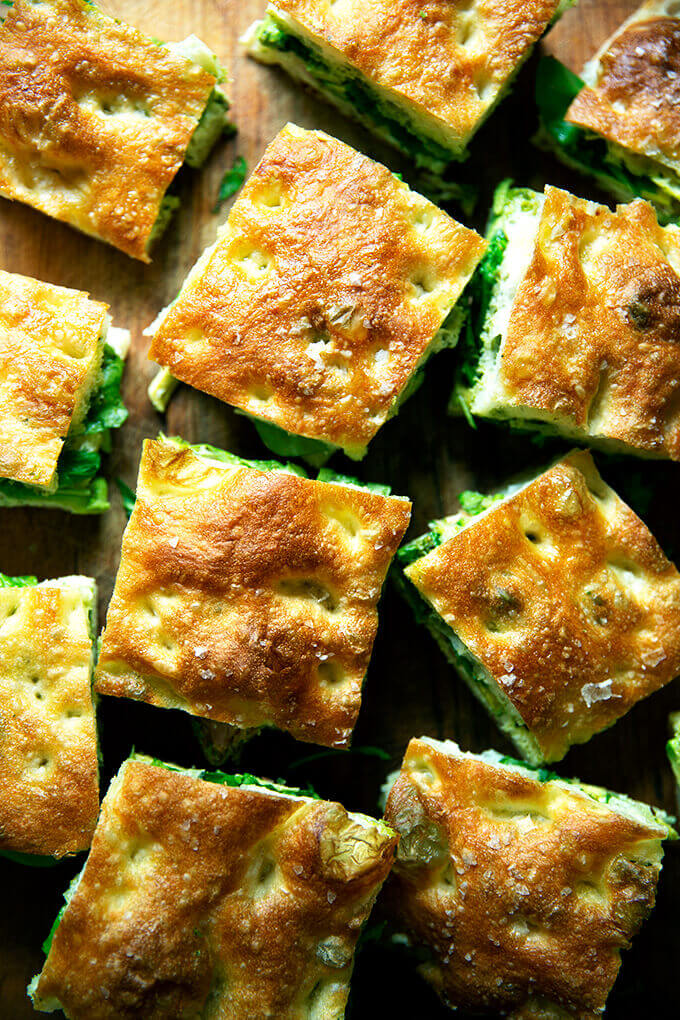
How to Make Focaccia Bread Sandwiches
One of my favorite things to do with either the rounds of focaccia or the 9×13-inch slab of focaccia is to make a giant sandwich: simply halve the whole finished loaf of focaccia in half crosswise; fill it as you wish, close the sandwich; then slice and serve.
Here’s one of my favorites: Roasted Red Peppers, Olive Tapenade, & Whipped Honey Goat Cheese
Can I Make this Overnight Focaccia Without the Overnight Rise?
Yes, you can. In fact, in my cookbook, Bread Toast Crumbs, I do not employ an overnight rise. Start-to-finish it can be made in about three hours. The finished bread will not be as pillowy, but it will still be light, airy, and delicious.
To skip the overnight rise, simply let the mixed dough rise at room temperature until doubled, about 1.5 to 2 hours. Then proceed with the recipe, knowing the second rise will only take about 30 minutes.
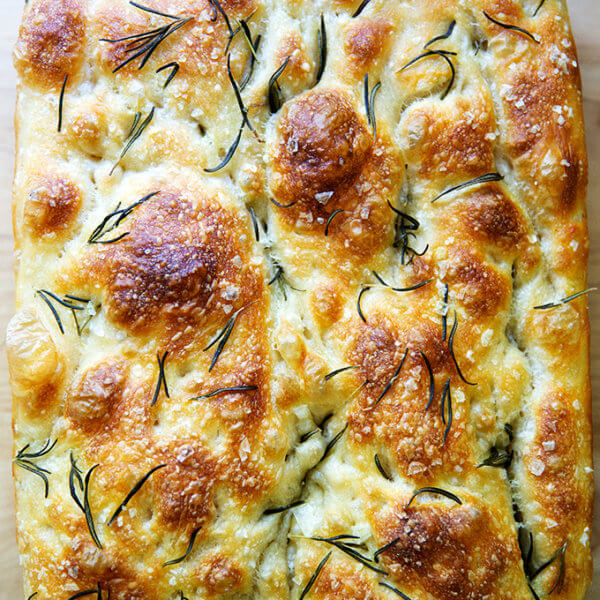
The Best, Easiest Focaccia Bread Recipe
- Total Time: 18 hours 30 minutes
- Yield: 2 loaves
Description
Cold, refrigerated dough is the secret to making delicious focaccia! Allowing the dough to rest 18 to 24 hours in the fridge will yield extra-pillowy and airy focaccia, though if you are pressed for time, you can make this start-to-finish in 3 hours. This 4-ingredient recipe requires only 5 minutes of hands-on time. Video guidance below!
Adapted from the focaccia recipe in Bread Toast Crumbs.
A few notes:
- Plan ahead: While you certainly could make this more quickly, it turns out especially well if you mix the dough the day before you plan on baking it. The second rise, too, takes 2 to 4 hours.
- If you are short on time and need to make the focaccia tonight: Let the mixed dough rise at room temperature until doubled, about 1.5 to 2 hours. Then proceed with the recipe, knowing the second rise will only take about 30 minutes.
- You can use various pans to make this focaccia such as: two 9-inch Pyrex pie plates. (Use butter + oil to prevent sticking.) One 9×13-inch pan, such as this USA pan — do not split the dough in half, if you use this option, which will create a thicker focaccia . A 13×18-inch rimmed sheet pan — this creates a thinner focaccia, which is great for slab sandwiches.
- As always, for best results, use a digital scale to measure the flour and water.
- I love SAF instant yeast. I buy it in bulk, transfer it to a quart storage container, and store it in my fridge for months. You can store it in the freezer also.
- If you are using active-dry yeast, simply sprinkle the yeast over the lukewarm water and let it stand for 15 minutes or until it gets foamy; then proceed with the recipe.
- Flour: You can use all-purpose or bread flour here with great results. If you live in a humid environment, I would suggest using bread flour. If you are in Canada or the UK, also consider using bread flour or consider holding back some of the water. Reference the video for how the texture of the bread should look; then add water back as needed.
Ingredients
- 4 cups (512 g) all-purpose flour or bread flour, see notes above
- 2 teaspoons (10 g) kosher salt
- 2 teaspoons (8 g) instant yeast, see notes above if using active dry
- 2 cups (455 g) lukewarm water, made by combining 1/2 cup boiling water with 1 1/2 cups cold water
- butter for greasing
- 4 tablespoons olive oil, divided
- flaky sea salt, such as Maldon
- 1 to 2 teaspoons whole rosemary leaves, optional
Instructions
- Make the dough: In a large bowl, whisk together the flour, salt, and instant yeast. Add the water. Using a rubber spatula, mix until the liquid is absorbed and the ingredients form a sticky dough ball. Rub the surface of the dough lightly with olive oil. Cover the bowl with a damp tea towel, cloth bowl cover, or plastic wrap and place in the refrigerator immediately for at least 12 hours or for as long as three days. (See notes above if you need to skip the overnight rise for time purposes.) NOTE: It is important the dough really be slicked with olive oil especially if you are using a cloth bowl cover or tea towel as opposed to plastic wrap or a hard lid. If you are using a tea towel, consider securing it with a rubber band to make a more airtight cover. If you do not slick the dough with enough oil, you risk the dough drying out and forming a crust over the top layer.
- Line two 8- or 9-inch pie plates or a 9×13-inch pan (see notes above) with parchment paper or grease with butter or coat with nonstick cooking spray. (Note: This greasing step may seem excessive, but with some pans, it is imperative to do so to prevent sticking. With my USA pans, I can get away with olive oil alone; with my glass baking dishes, butter is a must.)
- Pour a tablespoon of oil into the center of each pan or 2 tablespoons of oil if using the 9×13-inch pan. Using two forks, deflate the dough by releasing it from the sides of the bowl and pulling it toward the center. Rotate the bowl in quarter turns as you deflate, turning the mass into a rough ball. Use the forks to split the dough into two equal pieces (or do not split if using the 9×13-inch pan). Place one piece into one of the prepared pans. Roll the dough ball in the oil to coat it all over, forming a rough ball. Repeat with the remaining piece. Let the dough balls rest for 3 to 4 hours depending on the temperature of your kitchen (Note: no need to cover for this room temperature rise).
- Set a rack in the middle of the oven and preheat it to 425°F. If using the rosemary, sprinkle it over the dough. Pour a tablespoon of oil over each round of dough (or two tablespoons if using a 9×13-inch pan). Rub your hands lightly in the oil to coat, then, using all of your fingers, press straight down to create deep dimples. If necessary, gently stretch the dough as you dimple to allow the dough to fill the pan. Sprinkle with flaky sea salt all over.
- Transfer the pans or pan to the oven and bake for 25 to 30 minutes, until the underside is golden and crisp. Remove the pans or pan from the oven and transfer the focaccia to a cooling rack. Let it cool for 10 minutes before cutting and serving; let it cool completely if you are halving it with the intention of making a sandwich.
- Prep Time: 18 hours
- Cook Time: 30 minutes
- Category: Bread
- Method: Oven
- Cuisine: Italian
This post may contain affiliate links. Please read my disclosure policy.

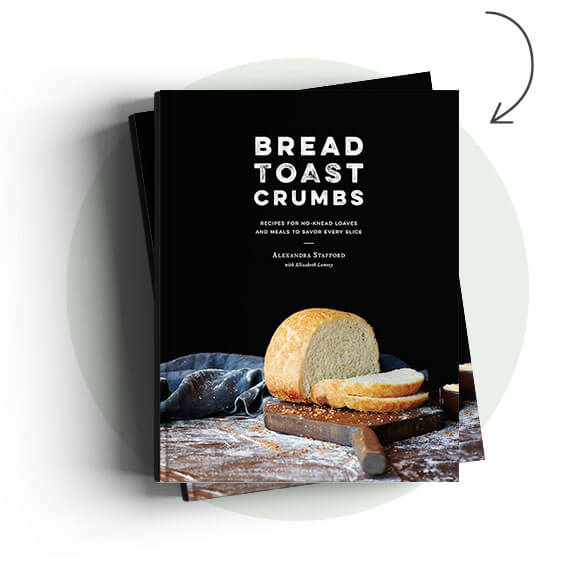

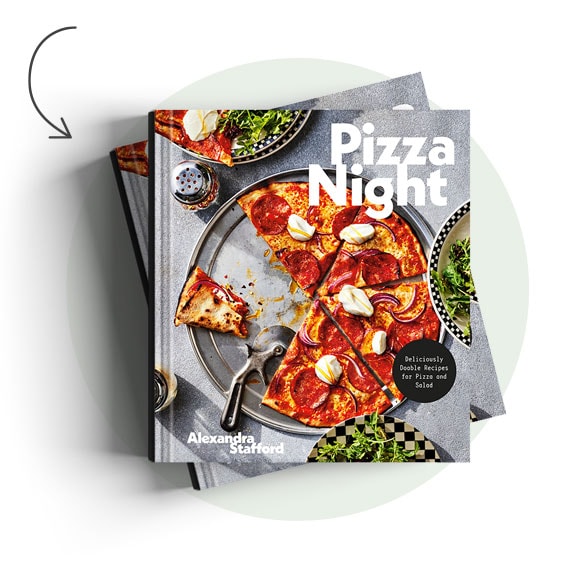


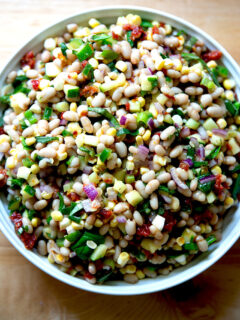
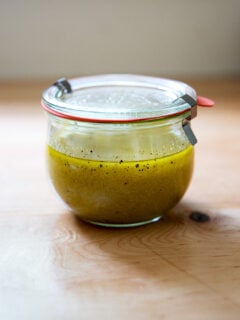
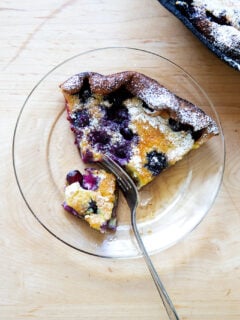


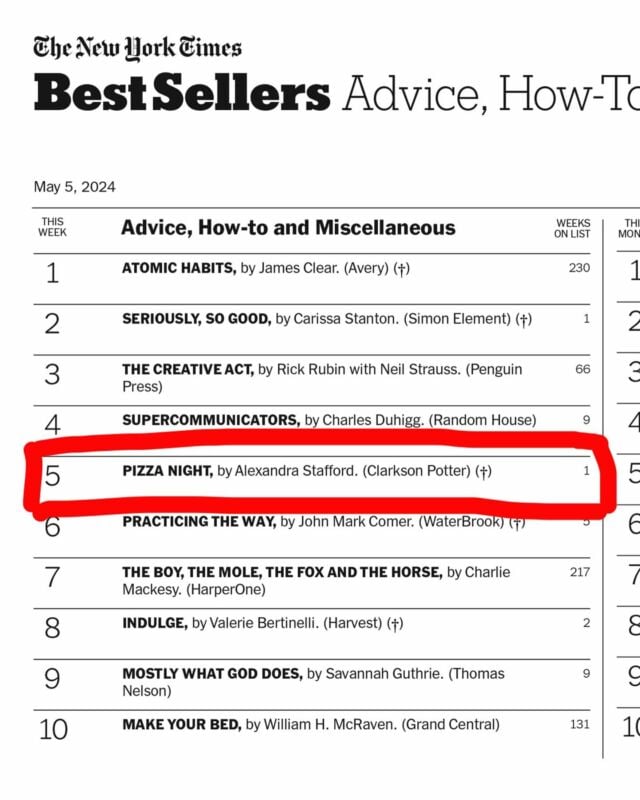



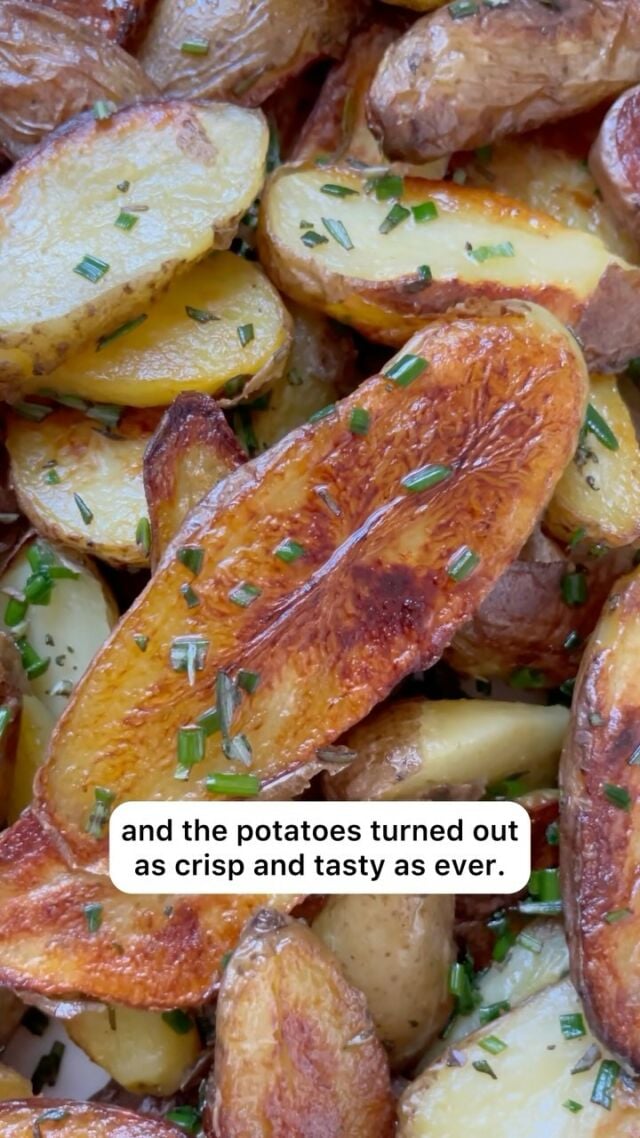
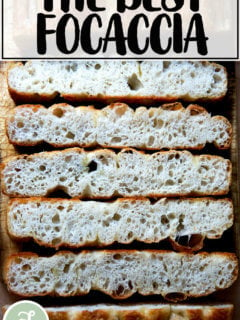
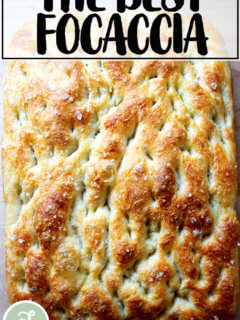
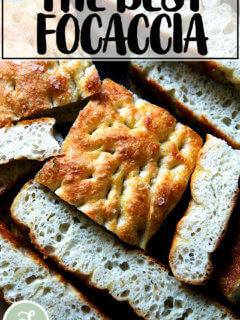
4,183 Comments on “Overnight, Refrigerator Focaccia = The Best Focaccia Bread Recipe”
Hi there!
I live In Minnesota and did this recipe for the first time today. It’s very cold here but I turned on the heater and tried to keep the house warm.
On the 2nd rise I waited 4h but the dough never covered the 9×13 pan. I am baking it now with the hopes it will turn out well but I noticed it looks flatter than yours.
Any reco on 2nd rise for cold places? Thank you!
Hi Mariana! Questions: on the first rise, did the dough double in the fridge? Or nearly double? What type of yeast are you using?
If you need a warm place for your dough to rise, you can turn it on for 1 minute; then turn it off. It will be around 100ºF or so. This will create a cozy place for your dough to rise. Covering the pan with plastic wrap may also help the dough rise in a timely manner.
My wife bought me this dough riser heating disc for Christmas last year. I was a little skeptical when I opened it, and it seems a little pricey, but it really is amazing and I recommended!
https://food52.com/shop/products/7770-raisenne-dough-riser
In Alexandra’s book for the peasant bread recipe, she has you preheat the oven for a few minutes, then shut it off and stick your pan in for the rise, so you can try that as well. Basically getting the oven up to a 100 or so degrees.
Thanks for sharing this, Joe! Looks like a great tool, especially for winter baking. My doughs are all rising so slowing right now.
Hey! I struggle to find warm places too. I’ve found with baking other breads that turning the oven light on and keeping the door closed provides just enough warmth without using any heat or turning the oven on!
Hi! Can I use regular salt instead of kosher salt?
By regular, do you mean table salt?
When I serve up this focaccia I’m told it’s the best they’ve ever tasted. Finished with cherry tomatoes, balsamic onions, olives and peppers it’s a delight. If you take out the time proving from the total time I reckon the actual amount of work involved Is about 10 minutes total. I’ve made the sourdough version as well and it’s just as good.
So nice to read all of this, Paul! Your toppings sound divine. Thanks so much for writing and sharing 🙂
Hi! I just made this for the first time and it ended up more like a biscuit than focaccia. Any idea why that would be? Thanks!
Hi Mac! Are you using a scale to measure? What type of flour are you using?
This was amazing! The texture is perfect. I always make home made buns or bread, which is great, but felt like a one trick pony. Doing this again! Thank you for the recipe and the tips!
Great to hear, Traci! Thanks so much for writing 🙂 🙂 🙂
I made this recipe for the first time to go with Christmas dinner. It came out perfectly!!! Ever since leaving Italy, we have missed having focaccia and this recipe is wonderful. Thank you for the recipe.
Great to hear, Nathalie!
I’ve made this a couple of times and it comes out perfect. My family now wants some every week. It comes out crispy but fluffy & soft on the inside. We love dipping it into eggs in purgatory. Definitely a must try recipe if you are a bread lover!
Great to hear, Mechelle!
The hydration of this recipe as written is too high at 89%, and I weighed to the gram. The result is more a batter than a dough. I should have trusted my experience and added more flour, but put it in the fridge and hoped for the best. The dough won’t hold the bubbles because there isn’t enough strength, and they rise and pop. A heads up that you may really want to adjust the water down to 80% of the flour weight so that others don’t have similar results.
Amazing recipe that yields pillowy crunchy focaccia.
Great to hear! Thanks for writing 🙂
I did it Ali — I made your focaccia!
After years of studying the recipe, I decided to give it a whirl this Christmas season. I followed your instructions to a T, and watched your YouTube video at least 5 times. I found it so helpful to compare the texture of the dough in your YouTube video to my dough at home.
While the focaccia baked, I watch my oven obsessively.
My first homemade focaccia bread turned out better than I expected! My family devoured the entire thing in 30 minutes, and asked for me to make more!
What a treat to be able to feed my family fresh bread at home. Thank you so much Ali for sharing such a detailed and well-tested recipe.
Liane!!! Oh my goodness, this makes me 2022 complete. Thank you so much for giving the recipe a go, and thank you for writing and sharing your notes/experience. So glad your family approved, too. Wishing you the very best 2023!!
First time making focaccia yesterday.
Made two different recipes, this being one of them.
It turned out perfect and was a huge hit!
The other one was a total fail and got chugged.
Will definitely be making this more!
Great to hear, Jane! Thanks so much for writing!
I made this today as my first time ever making focaccia bread and it came out amazing! Your instructions are perfect and I’m so excited to make this bread for my family.
Great to hear, Julianne! Thanks so much for writing 🙂
HI Ali from Canada,
Im curious as to why you recommend using bread flour instead of the flour I use for everything.
Robin Hood All purpose flour pre sifted. Would love to use King Arthur flour but alas not available here. No real competition! is it because King Arthur is a “hard” flour ?
The bread flour would probably be RobinHood Maybe its the protein content? Robin Hood is also available in unbleached.
Thanks
Donna
Hi Donna! I’m not exactly sure, but it has to do with how the different flours absorb water differently. Over the years, when I’ve troubleshooted with people in CA and the UK, the issue has been a too wet dough and the solution has been to use bread flour because it absorbs more water. Definitely use unbleached flour. You could try the Robin Hood unbleached flour and cut the water back from the start… reference the video for how the texture of the dough should look, and add more water as needed.
This was the easiest recipe and by far the tastiest focacchia. I used a little rosemary, thin sliced green onions and thin sliced cherry tomatoes. So satisfying and destined to become a frequent base recipe in this house. Thank you!
Yum to all of this! Thanks for writing and sharing 🙂 🙂 🙂
I read it in a Cooks Illustrated magazine years ago. If you need a warm, cozy place for your bread to rise use a cooler. Just place a hot water bottle, a bowl with boiling water, or even a heating pad in the bottom, put your dough inside, close the lid, and voila!
Smart! Great tip. Thanks for sharing, Larry!
I haven’t even tasted it yet but it’s BEAUTIFUL! I did use my mixer for ~7 minutes and gave it a bit extra hydration. Cold rise for 24 hours then a 4 hour second rise. Added rosemary ( of course) ,some oven roasted Roma tomatoes , and some shaved Parmesan. Just a sprinkle of coarse salt on the top.
Yum! Great to hear 🙂
I’m NOT a baker! My family freaked when I made this. We split it with a friend four hours ago and I already have the next batch in the fridge. Thank you! We can’t wait to add different toppings and experiment with this awesome base.
Wonderful to hear, Alex 🙂 🙂 🙂
Easily the best recipe and instructions on the Internet. Butter and oil the pan as the recipe instructs, it gives a beautiful crust with amazing flavor. I massaged in grated pecorino and pepper and it was so simple and savory. I cannot wait to make this again and again.
Wonderful to hear, Elie! Thanks so much for writing. Love the pecorino idea 🙂 🙂 🙂
This is the most amazingly delicious bread. My husband said it is better than sex. Ha Ha
Man can not live on bread alone. I
🤣🤣🤣🤣🤣🤣 Amazing 🎉🎉🎉🎉🎉🎉
i love this recipe its so good
Hello and happy new year!
Looking forward to making focaccia bread – just a quick question, can I make 1/2 or make make the full receipt and freeze 1/2 for later use?
Also, can I bake in a ramakin souffle dish?
Thank you, Terry
Yes to all of the above!
Hi,
I am running low on time and am in the middle of baking this focaccia,
My question is; can I freeze the focaccia for an hour or two rather than refrigerate?
Thanks
Serena!
Hi Serena,
Freezing unfortunately won’t expedite the process. If you need to make it faster, do this:
To skip the overnight rise, simply let the mixed dough rise at room temperature until doubled, about 1.5 to 2 hours. Then proceed with the recipe, knowing the second rise will only take about 30 minutes.
Hi Ali,
Would it work if i activated the dry yeast in some lukewarm water and a little sugar first. This way i can ensure yeast i’m using is still active. Sometimes, it’s not and i have to discard the yeast water and start again.
Thanks!
Karen
Yes, absolutely! No need to use the sugar though — lukewarm water is fine.
This bread is gorgeous! I let it rise for about 18 hours and made it with rosemary and sliced black olives. Huge hit at the gathering!
It did stick to the bottom of the pan so I’ll try baking it on parchment next time.
Great to hear, Jennifer! Thanks so much for writing. Bummer about the sticking. Parchment will help 🙂 🙂 🙂
When the amount of liquid is half amount of flour in cups, it shouldn’t be any different with grams. When I follow it with grams – I always prefer using a scale it came out more like batter. I recommend you to look into that. Otherwise I remember when I made it with this recipe for the first time it came out great! Must have used cups though. Thanks for the recipe!
Oh my word. This was as much fun to make as it was to eat. It accompanied some fabulous Atlantic muscles in wine sauce and while the seafood should have been the star of the dish, it was upstaged by this amazing bread.
I followed the recipe exactly. I can’t wait to make it again.
That sounds outstanding! I love mussels 🙂
I have made this at least half a dozen times, and it is amazing every time. I don’t make any other kind of bread, so I have no skills in this realm whatsoever, and it works every time 🙂 It was a wonderful addition to both our Christmas and New Year’s Eve dinners. I’ve used lemon olive oil, thyme, rosemary, and parmesan for the topping recently, but did one batch with tomatoes and basil, one with olives, onions, and garlic, and one with garlic pesto. They all worked, the rosemary has just felt right for the holidays 🙂
Thank you so much for sharing this recipe, and for the tips!
So nice to read all of this Megan 🙂 🙂 🙂 Thanks so much for writing and sharing all of your notes. All of your toppings sound delicious!
This is now my go-to bread recipe, and I’ve shared with so many other people! It is perfect: airy, crispy, soft, and yeasty. I’ve also used it as a base to literally *the BEST* pizza I’ve ever eaten (with a San Marzano sauce, prosciutto, fresh mozzarella, and basil). Thank you for sharing this!
Great to read all of this, Mariah! Your pizza sounds amazing!!
I was in a hurry and wanted to try your “fast” version of this recipe. Let me just say I went in with no expectations and followed it to a “T” and it turned out delicious!!!! I now have a batch in the fridge to cold proof for about 20 hours likely and can’t wait to compare and contrast. Thank you for an easy and amazingly delicious recipe!
Great to hear, Chiara! I’ll be interested to hear as well 🙂 🙂 🙂
I’ve made this recipe so many times to the point where my friends beg me to make it. My friend who has moved out of town always jokes that she’s only coming for this bread whenever she comes up to visit. I’ve played around a lot with this recipe and experimented with different flavors and my personal favorite is a goat cheese + caramelized onion bread.
I whip the goat cheese and spread it over the bread (after the second rise) then lay on the onions — comes out amazing!
Anyway, I’ve made the recipe again today because I have friends coming over, and I realized that I haven’t even reviewed the recipe despite making it so many times. Thank you so much for the excellent recipe 🙂
So nice to read all of this, Taz! Thanks so much for taking the time to review the recipe. I am going to try the whipped goat cheese + caramelized onion version. Sounds amazing!
I’m not sure why my foccacia lacked flavor. Not very deep. I proofed in fridge almost 48 hours and 2 hours outside. Maybe proof longer outside? Perhaps use active yeast instead of quick rising? I did use quality olive oil, salt and King Arthur bread flour…Any suggestions for tastier bread itself NOT toppings?